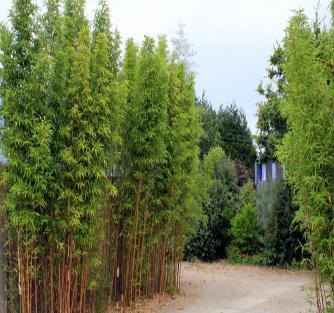Live Green, Love Green, Think Green
South Florida Landscape Plants
| Bamboo Palm Chamaedorea spp. The bamboo palm is the perfect answer for South Florida homeowners searching for hard-to-find pretty plants for a shade garden. Bamboo palm leaves This palm's name is often used for several different palms but all have the distinct look of bamboo. These chamadoreas grow slowly with a clustering, spreading habit. It produces short elegant fronds and attractive, upright stalks which look like thin bamboo canes. Most of these palms are small - from Neantha Bella (Chamaedorea elegans) which only grows to about 3 feet, to Chamaedorea microspadix (commonly sold at nurseries as "Bamboo Palm") which can get 7 to 10 feet tall. They're mainly "understory palms" so they like a shaded area with regular moisture - more, in fact, than most other landscape palms. Plant specs Bamboo palms usually reach no more than 7 feet tall in the landscape. Though they're clustering - sending up new shoots from the base of the plant - they grow slowly and won't take over an area. Most are tender and tropical - best in Zone 10. They can also be grown in sheltered areas of Zone 9B, planted in an area protected from drying winds and frost. Stalk detail This is a great indoor plant (see box below) anywhere in South Florida, especially nice in colder regions where you can bring it outdoors during warm weather and indoors to protect from winter's cold. Plant care Plant with plenty of organic peat (or top soil) in the hole to help the palm retain moisture around its roots. Add Hortasorb® or another water-retaining product (see Gardening How-To page on Watering for more information on using Hortasorb® to keep your plants from drying out) to the hole when you plant to make the soil's moisture longer lasting. Add a thick layer of mulch. Bamboos don't like standing water, however, so make sure the location drains well after a hard rain. Position the palm in an area that gets no more than dappled sun (or a little morning sun) - or in full shade. Tender and tropical, a bamboo palm needs cold protection, and placement in the landscape is often the best way to protect it. A location in a shaded spot usually means there is tree canopy coverage to protect it from frost. Avoid windswept areas that will dry out the soil and burn the tips of the palm's leaves. Fertilize at least three times per year (summer, fall and spring) with a slow-release granular fertilizer that contains micronutrients. Trimming will be minimal - only to remove a browned frond or old stalk occasionally. Cut the stalk off at ground level. Although the palm spreads, any errant shoots can be cut off or dug out to keep the plant contained. Bamboo palms make great houseplants. This palm is often called the "Parlor Palm" because it takes indoor conditions well - with the right care. Use in an area of the house that provides good indirect light. If the palm sits in front of a bright window with some sun, make sure the window is screened to filter the light. Humidity is rare in a Florida home - air-conditioning and heat can dry out any plant in no time flat. Try to avoid placement directly in front of an air vent...and help increase humidity with the following: Set the pot on top of a deep saucer filled with rocks. Fill the saucer with water - the rocks will keep the palm from sitting in water, while providing needed humidity. Make sure the saucer always holds water and do a regular top watering to give the palm a good drink. Plant spacing For a screen or "hedge", bamboo palms can be planted right next to each other or somewhat farther apart since they'll grow together eventually (this may take a while since they're slow growers). They work very well around trees, since they'll spread over root buttresses with no difficulty. Plant as close to the tree as possible, wherever you can dig a hole large enough to accomodate the palm's root ball. This palm makes a good patio or pool cage container plant - make sure the pool cage screening provides at least 30% diffused light, or place it back near the house in a shadier spot. Landscape uses for bamboo palm screen, hedge or filler in a container indoors or out accent plant for architectural elements of height, such as columns or pillars taller backdrop for small plants in a shade garden |

